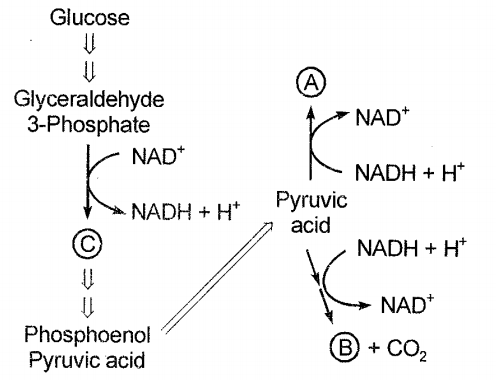In the figure given below the correct match is:

1. A-Ethanol, B-Lactic acid, C-Dihydroxyacetone phosphate
2. A-Lactic acid, B-Ethanol, C-Oxaloacetic acid
3. A-Lactic acid, B-Ethanol, C-3-Phosphoglyceric acid
4. A-Ethanol, B-Lactic acid, C-3-phosphoglyceric acid
Consider the statements a, b, c and d with respect to fermentation by yeast and select the correct choice
a. Production of and ethanol
b. Complete oxidation of glucose
c. The reducing agent is NADH +
d. It is achieved under anaerobic condition
1. a & b are incorrect
2. b is incorrect
3. a & c is incorrect
4. all are incorrect
Consider the following statements about fermentation
a. Yeast produces and ethanol by incomplete oxidation of glucose.
b. Some bacteria produce lactic acid from pyruvic acid.
c. In both lactic acid and alcohol fermentation, a lot of energy is released.
d. H2O is not released.
The correct statements are
1. Only a & d
2. a, b & d
3. b & d
4. a, c & d
| Assertion (A): | Yeast is involved in alcoholic fermentation. |
| Reason (R): | Yeast poison themselves to death when concentration of alcohol reaches about 13%. |
| 1. | Both (A) and (R) are True and (R) correctly explains (A). |
| 2. | Both (A) and (R) are True but (R) does not correctly explain (A). |
| 3. | (A) is True, (R) is False. |
| 4. | Both (A) and (R) are False |
| Assertion (A): | The maximum concentration of alcohol in beverages that are naturally fermented with yeast is about 13%. |
| Reason (R): | In alcohol fermentation, yeast converts pyruvic acid to ethanol and carbon dioxide. |
| 1. | Both (A) and (R) are True and (R) is the correct explanation of (A). |
| 2. | Both (A) and (R) are True but (R) is not the correct explanation of (A). |
| 3. | (A) is True but (R) is False. |
| 4. | Both (A) and (R) are False. |
| Statement I: | In fermentation, there is a net gain of 12 molecules of ATP for each molecule of glucose degraded to pyruvic acid whereas only 2 molecules of ATP are generated under aerobic conditions. |
| Statement II: | Fermentation accounts for only a partial breakdown of glucose whereas in aerobic respiration it is completely degraded to CO2 and H2O. |
1. Both Statement I and Statement II are correct.
2. Both Statement I and Statement II are incorrect.
3. Statement I is correct but Statement II is incorrect.
4. Statement I is incorrect but Statement II is correct.
| Statement I: | The first five reactions of glycolytic pathway convert a molecule of glucose into 2 molecules of glyceraldehyde-3-phosphate. |
| Statement II: | The final product of glycolysis is pyruvate in aerobic settings and lactate in anaerobic conditions. |
1. Both Statement I and Statement II are correct.
2. Both Statement I and Statement II are incorrect.
3. Statement I is correct but Statement II is incorrect.
4. Statement I is incorrect but Statement II is correct.
| Assertion (A): | Fermentation accounts for only a partial breakdown of glucose. |
| Reason (R): | There can be a net gain of 38 ATP molecules during aerobic respiration of one molecule of glucose. |
| 1. | Both (A) and (R) are True and (R) correctly explains (A). |
| 2. | Both (A) and (R) are True but (R) does not correctly explain (A). |
| 3. | (A) is True, (R) is False. |
| 4. | (A) is false but (R) is true. |




